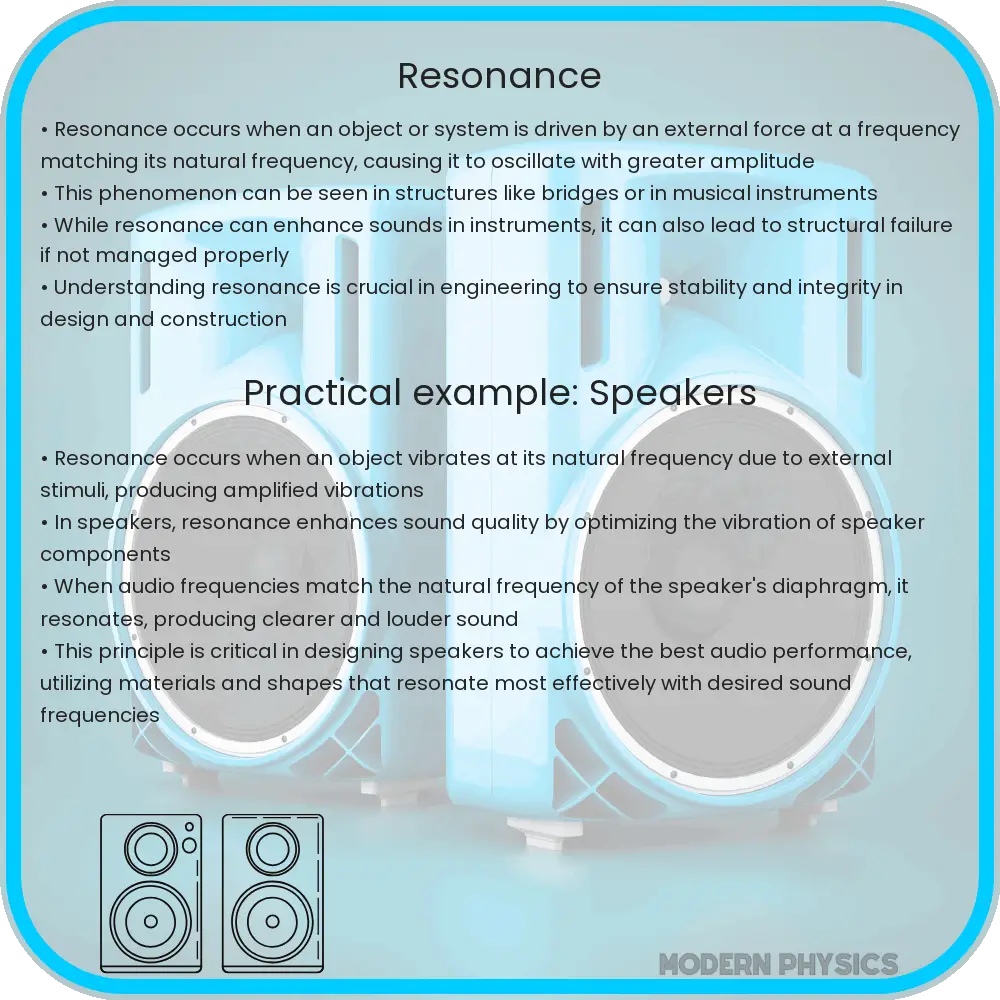Explore the fascinating world of resonance in classical mechanics, its examples, applications, and theoretical insights in this comprehensive guide.

Understanding Resonance in Classical Mechanics
Resonance is a fundamental concept in classical mechanics, central to understanding various physical phenomena. It occurs when a system vibrates at its maximum amplitude under the influence of an external force that matches the system’s natural frequency. This principle is pivotal in fields ranging from engineering to musical instrument design.
Examples of Resonance
One of the most illustrative examples of resonance is a swing. When pushed at a regular interval, the swing reaches higher amplitudes – a result of the external force (the push) resonating with the swing’s natural frequency. Another classical example is the Tacoma Narrows Bridge collapse in 1940, demonstrating the catastrophic effects of resonance when wind-induced vibrations matched the bridge’s natural frequency.
Applications of Resonance
Resonance finds applications in various fields:
- Engineering: In mechanical engineering, resonance is a critical factor in the design of structures like buildings and bridges to ensure they can withstand natural forces without resonant vibrations.
- Medical Field: Magnetic Resonance Imaging (MRI) employs resonance principles to create detailed images of the body’s internal structures.
- Music: Musical instruments, such as guitars and violins, use resonance to amplify sound. The shape and material of the instrument’s body are designed to resonate at frequencies that enhance the sound quality.
Mathematical Representation of Resonance
In classical mechanics, the mathematical representation of resonance is often illustrated using the simple harmonic oscillator model. This model describes a system where the restoring force is proportional to the displacement, typically represented as:
F = -kx
Where F is the force, k is the spring constant, and x is the displacement from the equilibrium position. At resonance, the amplitude of oscillation reaches its peak, and the system absorbs maximum energy from the external force.
In the following sections, we will delve deeper into the theoretical aspects of resonance, exploring its mathematical foundation and the conditions required for its occurrence.
Theoretical Aspects of Resonance
The phenomenon of resonance can be explained using the principles of wave mechanics and oscillations. At the core of these principles is the concept of natural frequency, the rate at which a system oscillates in the absence of external forces. When an external force drives the system at a frequency close to its natural frequency, resonance occurs, leading to a significant increase in the amplitude of oscillation.
Conditions for Resonance
Resonance arises under specific conditions:
- Matching Frequencies: The frequency of the external force should closely match the natural frequency of the system.
- Damping Effects: Lower damping in a system facilitates greater resonance, as energy is less likely to be lost to friction or other resistance forces.
- Energy Transfer: Efficient transfer of energy from the external source to the system is crucial for resonance to occur.
Preventing Resonance-Related Failures
Understanding resonance is not only essential for harnessing its benefits but also for preventing potential disasters. In engineering, for instance, structures are designed to have natural frequencies far from the frequencies of expected external forces. Additionally, damping mechanisms are incorporated to absorb energy and minimize resonance effects.
Resonance in Quantum Mechanics
Resonance extends beyond classical mechanics into the realm of quantum mechanics. In quantum systems, resonance can be observed in phenomena such as electron orbitals and the behavior of subatomic particles in accelerators.
Conclusion
Resonance, a fundamental concept in classical mechanics, has profound implications across various scientific and engineering disciplines. From the engineering of safe structures to the development of medical imaging techniques and musical instruments, the understanding of resonance is crucial. It exemplifies the beauty and complexity of physical phenomena, where a simple principle can have wide-reaching applications and implications. As technology advances, the study of resonance continues to evolve, offering new insights into the fundamental workings of both the macroscopic and microscopic worlds.
